| 1 |
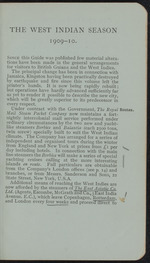 |
“...THE WEST INDIAN SEASON
1909—10.
Since this Guide was published few material altera-
tions have been made in the general arrangements
for visitors to British Guiana and the West Indies.
The principal change has been in connection with
Jamaica, Kingston having been practically destroyed
by earthquake and fire since this volume left the
printer’s hands. It is now being rapidly rebuilt;
but operations have hardly advanced sufficiently far
as yet to render it possible to describe the new city,
which will Be greatly superior to its predecessor in
every respect.
Under contract with the Government, The Royal Routes.
Mail Steam Packet Company now maintains a fort-
nightly intercolonial mail' service performed under
ordinary circumstances by the two new and yacht-
like steamers Berbice and Balantia (each 2500 tons,
twin screw) specially built to suit the West Indian
climate. The Company has arranged for a series of
independent and organised tours during the winter
from England and New York at prices...”
|
|
| 2 |
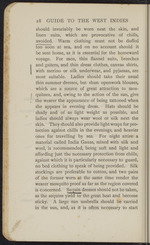 |
“...their usual
thin summer dresses, but shun openwork blouses,
which are a source of great attraction to mos-
quitoes, and, owing to the action of the sun, give
the wearer the appearance of being tattooed when
she appears in evening dress. Hats should be
shady and of as light weight as possible, and
ladies should always wear wool or silk next the
skin. They should also provide light wraps for pro-
tection against chills in the evenings, and heavier
ones for travelling by sea. For night attire a
material called India Gauze, mixed with silk and
wool, is recommended, being soft and light and
affording just the necessary protection from chills,
against which it is particularly necessary to guard,
no bed clothing to speak of being provided. Silk
stockings are preferable to cotton, and two pairs
of the former worn at the same time render the
wearer mosquito proof as far as the region covered
is concerned. Sequin dresses should not be taken,
as the sequins yield to the great heat and become
sticky...”
|
|
| 3 |
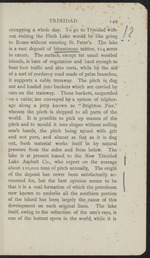 |
“...palm branches,
it supports a cable tramway. The pitch is dug
out and loaded into buckets which are carried by
cars on the tramway. These buckets, suspended
on a cable, are conveyed by a system of telpher-
age along a jetty known as “ Brighton Pier,”
whence the pitch is shipped to all parts of the
world. It is possible to pick up masses of the
pitch and to mould it into shapes without soiling
one’s hands, the pitch being mixed with grit
and not pure, and almost as fast as it is dug
out, fresh material works itself in by natural
pressure from the sides and from below. The
lake is at present leased to the New Trinidad
Lake Asphalt Co., who export on the average
about 110,000 tons of pitch annually. The origin
of the deposit has never been satisfactorily ac-
counted for, but the best opinion seems to be
that it is a coal formation of which the petroleum
now known to underlie all the southern portion
of the island has been largely the cause of this
development on such original lines. The lake...”
|
|
| 4 |
 |
“...on 7th May
1902, a day in advance of La Montagne Pelée in
Martinique, after being quiescent since 1812, and
continued in a state of activity until March 1903.
The following account of the eruption, which re-
sulted in the loss of 2000 lives, was given by the
Rev. J. H. Darrell of Kingstown, who was an
eye-witness of this appalling event:—
“At 7 a.m. on Wednesday, the 7th instant,
there was another sudden and violent escape of
pent-up steam, which continued ascending till
10 a.m., when other material began to be ejected.
It would seem that this was the time when the
enormous mass of water in the lake of the old
crater was emitted in gaseous condition. . . . The
mountain heaved and laboured to rid itself of the
burning mass of lava heaving and tossing below.
By 12.30 p.m. it was evident that it had begun...”
|
|
| 5 |
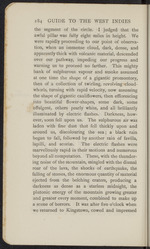 |
“...volcanic material, descended
over our pathway, impeding our progress and
warning us to proceed no farther. This mighty
bank of sulphurous vapour and smoke assumed
at one time the shape of a gigantic promontory,
then of a collection of twirling, revolving cloud-
whorls, turning with rapid velocity, now assuming
the shape of gigantic cauliflowers, then efflorescing
into beautiful flower-shapes, some dark, some
effulgent, others pearly white, and all brilliantly
illuminated by electric flashes. Darkness, how-
ever, soon fell upon us. The sulphurous air was
laden with fine dust that fell thickly upon and
around us, discolouring the sea; a black rain
began to fall, followed by another rain of favilla,
lapilli, and scoriae. The electric flashes were
marvellously rapid in their motions and numerous
beyond all computation. These, with the thunder-
ing noise of the mountain, mingled with the dismal
roar of the lava, the shocks of earthquake, the
falling of stones, the enormous quantity of material
ejected...”
|
|
| 6 |
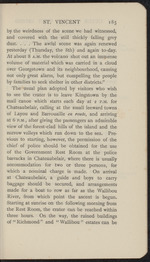 |
“...ST. VINCENT
i85
by the weirdness of the scene we had witnessed,
and covered with the still thickly falling grey
dust. . . . The awful scene was again renewed
yesterday (Thursday, the 8th) and again to-day.
At about 8 a.m. the volcano shot out an imijiense
volume of material which was carried in a cloud
over Georgetown and its neighbourhood, causing
not only great alarm, but compelling the people
by families to seek shelter in other districts.”
The usual plan adopted by visitors who wish
to see the crater is to leave Kingstown by the
mail canoe which starts each day at 2 p.m. for
Chateaubelair, calling at the small leeward towns
of Layou and Barrouaille en route, and arriving
at 6 p.m., after giving the passengers an admirable
view of the forest-clad hills of the island and the
narrow valleys which run down to the sea. Pre-
vious to starting, however, the permission of the
chief of police should be obtained for the use
of the Government Rest Room at the police
barracks in Chateaubelair,...”
|
|
| 7 |
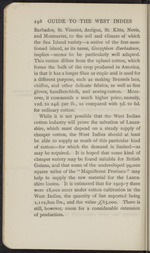 |
“...it is not possible that the West Indian
cotton industry will prove the salvation of Lanca-
shire, which must depend on a steady supply of
cheaper cotton, the West Indies should at least
be able to supply as much of this particular kind
of cotton—for which the demand is limited—as
may be required. It is hoped that some kind of
cheaper variety may be found suitable for British
Guiana, and that some of the undeveloped 99,000
square miles of the “Magnificent Province” may
help to supply the raw material for the Lanca-
shire looms. It is estimated that for 1905-7 there
were 18,000 acres under cotton cultivation in the
West Indies, the quantity of lint exported being
1,122,800 lbs., and the value ,£63,000. There is
still, however, room for a considerable extension
of production....”
|
|
